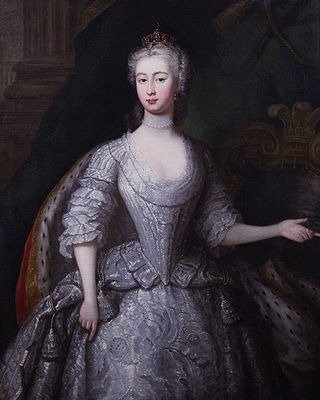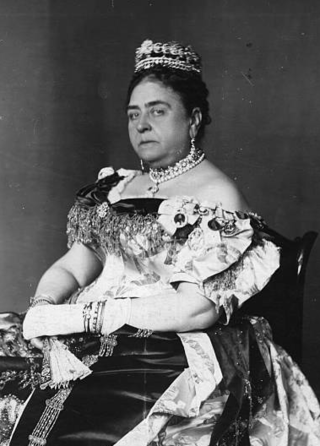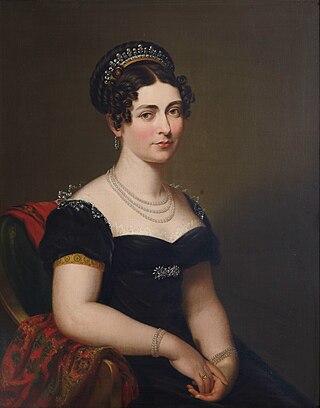
Princess Augusta of Saxe-Gotha-Altenburg was Princess of Wales by marriage to Frederick, Prince of Wales, eldest son and heir apparent of King George II. She never became queen consort, as Frederick predeceased his father in 1751. Augusta's eldest son succeeded her father-in-law as George III in 1760. After her spouse died, Augusta was the presumptive regent of Great Britain in the event of a regency, until her son reached majority in 1756.

Princess Mary Adelaide of Cambridge, later known as the Duchess of Teck, was a member of the British royal family. She was one of the first royals to patronise a wide range of charities and was a first cousin of Queen Victoria.

Prince Augustus Frederick, Duke of Sussex, was the sixth son and ninth child of King George III and his queen consort, Charlotte of Mecklenburg-Strelitz. He was the only surviving son of George III who did not pursue an army or navy career. A Whig, he was known for his liberal views, which included reform of Parliament, abolition of the slave trade, Catholic Emancipation, and the removal of existing civil restrictions on Jews and Dissenters.

Princess Augusta of Cambridge was a member of the British royal family, a granddaughter of George III. She married into the Grand Ducal House of Mecklenburg-Strelitz and became Grand Duchess of Mecklenburg-Strelitz.

George V was the last king of Hanover, reigning from 18 November 1851 to 20 September 1866. The only child of King Ernest Augustus and Queen Frederica, he succeeded his father in 1851. George's reign was ended by the Austro-Prussian War, after which Prussia annexed Hanover.

Princess Augusta of Hesse-Kassel was the wife of Prince Adolphus, Duke of Cambridge, the tenth-born child, and seventh son, of George III of the United Kingdom and Charlotte of Mecklenburg-Strelitz. The longest-lived daughter-in-law of George III, she was the maternal grandmother of Mary of Teck, wife of George V.

Princess Victoria of Saxe-Coburg-Saalfeld, later Princess of Leiningen and subsequently Duchess of Kent and Strathearn, was a German princess and the mother of Queen Victoria of the United Kingdom. As the widow of Charles, Prince of Leiningen, from 1814, she served as regent of the Principality during the minority of her son from her first marriage, Carl, until her second wedding in 1818 to Prince Edward, fourth son of George III.

Adolphus Frederick II, Duke of Mecklenburg, was the first Duke of the Mecklenburg-Strelitz, reigning from 1701 until his death. Mecklenburg-Strelitz was a part of the Holy Roman Empire.

Danilo Aleksandar Petrović-Njegoš was the Crown Prince of Montenegro. He was the eldest son of King Nicholas I of Montenegro and Queen Milena Vukotić.

Princess Marie Luise Alexandrina of Saxe-Weimar-Eisenach was a princess of Saxe-Weimar-Eisenach, by birth, and, by marriage, a princess of Prussia. She was the daughter of Charles Frederick, Grand Duke of Saxe-Weimar-Eisenach and Grand Duchess Maria Pavlovna of Russia.

Princess Elisabeth of Anhalt was the Grand Duchess of Mecklenburg-Strelitz from 1904 to 1914 as the spouse of Adolf Friedrich V, Grand Duke of Mecklenburg-Strelitz.

Duchess Marie of Mecklenburg-Strelitz was the eldest daughter of Adolf Friedrich V, Grand Duke of Mecklenburg-Strelitz and his wife Princess Elisabeth of Anhalt.

The Grand Duchy of Mecklenburg-Strelitz was a territory in Northern Germany, held by the younger line of the House of Mecklenburg residing in Neustrelitz. Like the neighbouring Grand Duchy of Mecklenburg-Schwerin, it was a sovereign member state of the German Confederation and became a federated state of the North German Confederation and finally of the German Empire upon the unification in 1871. After World War I and the German Revolution of 1918–19 it was succeeded by the Free State of Mecklenburg-Strelitz.

Adolphus Frederick V was reigning grand duke of Mecklenburg-Strelitz from 1904 to 1914.

Frederick William was a German sovereign who ruled over the state of Mecklenburg-Strelitz as grand duke from 1860 until his death.

George ruled the state of Mecklenburg-Strelitz as Grand Duke of Mecklenburg from 1816 until his death.

The Royal Family Order of George IV is an honour that was bestowed as a mark of personal esteem on female members of the British royal family by King George IV. It was the first Royal Family Order issued in the United Kingdom. Prior to George IV's accession in 1820, both ladies and gentlemen of the Court, as well as female members of the royal family, had worn the Sovereign's portrait set in a jewelled frame. George IV formalised the order.

Princess Marie of Prussia, was a princess of the House of Hohenzollern. She was the daughter of Prince Frederick Charles of Prussia and later became second wife of Prince Henry of the Netherlands then the first wife of Prince Albert of Saxe-Altenburg. She was also the great-niece of Wilhelm I, German Emperor.

St George's Chapel at Windsor Castle in England is a castle chapel built in the late-medieval Perpendicular Gothic style. It is a Royal Peculiar, and the Chapel of the Order of the Garter. St George's Chapel was founded in the 14th century by King Edward III and extensively enlarged in the late 15th century. It is located in the Lower Ward of the castle.

Princess Marie of Hesse-Kassel was the consort of George, Grand Duke of Mecklenburg-Strelitz.




















